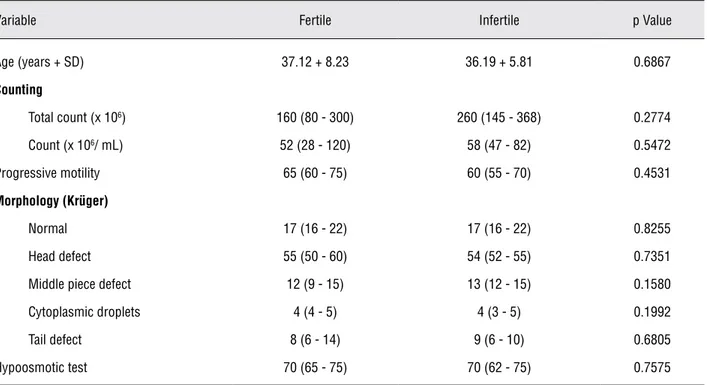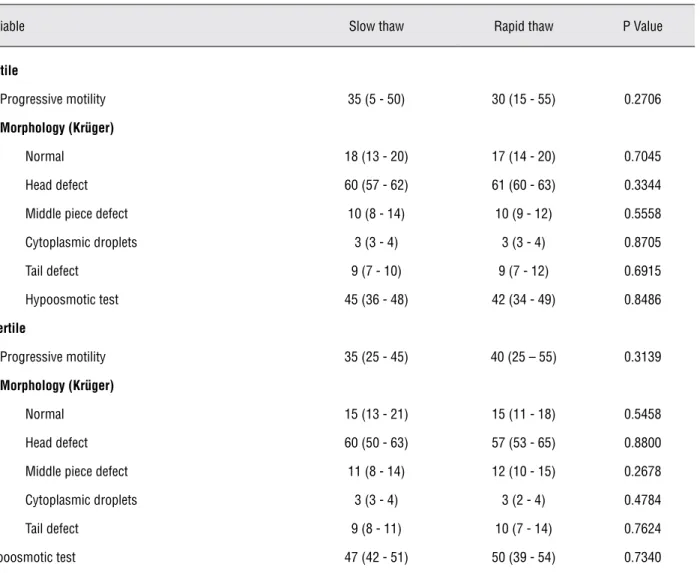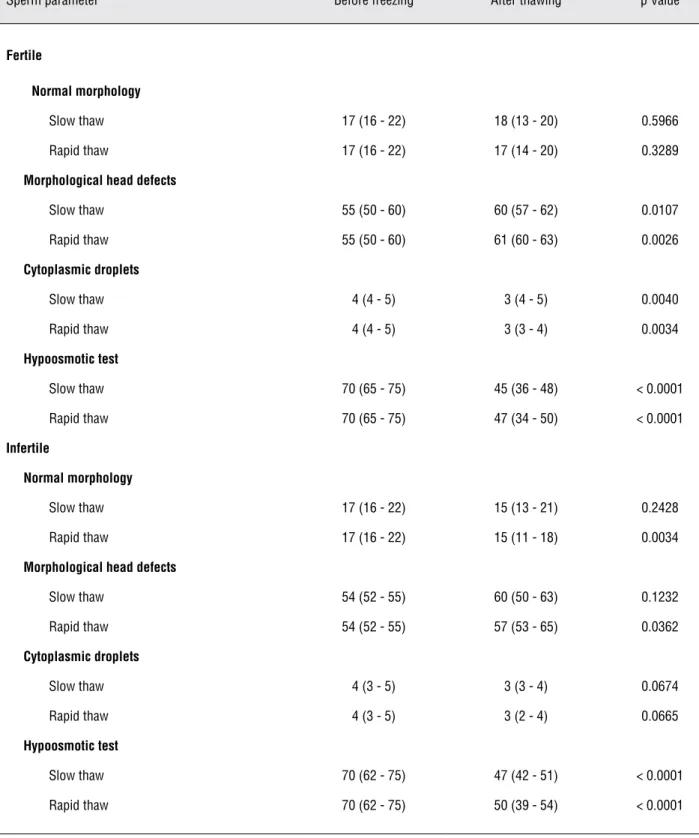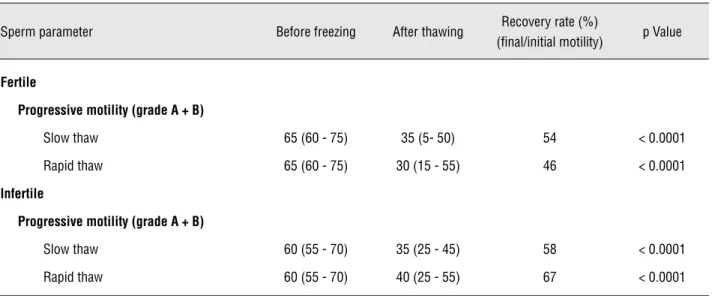INTRODUCTION
Sperm quality of thawed samples is still considered unsatisfactory due to relatively low recovery rate of viable sperm after freezing and thawing processes, as less than 60% of them re-gain motility after thawing (1).
Several studies have been published about animal sperm cryopreservation showing better results regarding the viability of the sperm after thawing. Many sperm thawing protocols for animals use high heating levels (above 50º C) and obtain good motility recovery rates (2-4).
Purpose: To compare sperm recovery from slow versus rapid thawing technique using thirty-eight normozoospermic human sperm samples, as follows. Twenty-one samples from men taking part in routine infertility screening exams (infertile group) and seventeen from proven fertile volunteer men with at least one child (fertile group).
Materials and Methods: After analysis of motility, concentration, strict morphol-ogy and functional integrity of membranes, sperm was divided into two aliquots of 0.5 mL each and frozen in TyB-G medium. Samples were thawed at room tem-perature (25 ± 2º C) for 25 minutes (slow thaw) or in a water bath at 75º C for 20 seconds followed by water bath at 37º C for 3 minutes (rapid thaw). After thawing, motility, strict morphology and functional integrity of membranes were evaluated by a blinded investigator. The results were expressed as mean ± standard deviation for parametric variables and analyzed using Student’s t-test. Data with unpaired non-parametric variables were expressed as median (interquartile range) and ana-lyzed by the Mann-Whitney test. Wilcoxon test was used to analyze non-paramet-ric paired variables.
Results: There was no significant difference between techniques for total and progres-sive motility, percentage of normal morphological forms, hypoosmotic swelling test. Conclusions: Although the rapid thawing protocol was completed in a shorter time (three minutes and 20 seconds versus 25 minutes, respectively), it wasn’t harm-ful since both techniques showed comparable spermatozoa recovery. Additional research is needed to confirm its safety in clinical research before introducing this methodology in routine assisted reproduction.
Rapid thawing human sperm does not affect basic
parameters in normozoospermic men: a double-blind
prospective study
_______________________________________________
Marco A. Vieira, Simone F. Nery, Rubens L. Tavares, Cynthia Dela Cruz, Fernando M. Reis, Aroldo F.
Camargos
Professor Aroldo Fernando Camargos Laboratory of Human Reproduction, (MAV, SFN, RLT, CDC, FMR, AFC) and Department of Obstetrics and Gynecology, Federal University of Minas Gerais, (FMR, AFC), Belo Horizonte, Brazil
ABSTRACT
ARTICLE
INFO
_______________________________________________________________ _____________________
Key words:
sperm; cryopreservation; sperm bank;
semen preservation; spermatozoa
Int Braz J Urol. 2012; 38: 108-115
________________
Submitted for publication: August 17, 2011
________________
There is not a consensus protocol for thawing human semen, which can be done in several ways. Semen can be thawed at room temperature for about 5-60 minutes or using a water bath at 37º C for 5-10 minutes or with both techniques (5-10). Accordingly to our protocol, cryogenic vial samples are removed from the liq-uid nitrogen and allowed to thaw at room tem-perature (25º ± 2º C) for 25 minutes to achieve a complete thaw before being processed (5,8). This procedure has been performed for several years with good clinical results.
We aim to investigate whether the use of a higher thawing temperature (75º C) would be harmful to human spermatozoa when compared with room temperature (25º ± 2º C) thawing re-garding motility, morphology and integrity of sperm membranes, and if it would be feasible to introduce this technique in routine assisted reproduction.
MATERIALS AND METHODS
This study was carried out from Septem-ber 25 to NovemSeptem-ber 4, 2009, at Professor Aroldo Fernando Camargos Laboratory of Human Re-production, Federal University of Minas Gerais. All participants signed a consent form and com-pleted a questionnaire about reproductive his-tory. This research has been approved by The Ethics Committee under protocol number COEP-UFMG 348/08.
Only subjects who provided semen with-in the standard parameters (normozoospermic, semen volume ≥ 2 mL) set by the 1999 World Health Organization were included (11). Thirty-eight men provided sperm samples. Twenty-one of them from routine infertility screening exams (infertile group) and seventeen were proven fertile volunteers with at least one child (fertile group).
Sperm was obtained by masturbation into a non-toxic sterile collector, after two to five days from last intercourse or ejaculation. Once collected, sperm was maintained at 37º C on a warm plate until total liquefaction. Sam-ples were analyzed within 60 minutes after ejac-ulation for concentration, motility, morphology and functional sperm membrane integrity and
basic macroscopic parameters (liquefaction, volume, color, viscosity, pH). Rapid progressive spermatozoa (type a), slow progressive sperma-tozoa (type b), non progressive (type c) and im-motile (type d) were defined in conformity with WHO criteria (1999). All counts were done in a Neubauer chamber after appropriate dilutions of semen aliquots.
Morphology was evaluated by the he-matoxylin staining technique and slides were analyzed by the Kruger strict criteria (12). Mor-phology of two hundred randomly chosen sper-matozoa were assessed using a Carl Zeiss® opti-cal microscope with 1,000 X millimetered ocular lens under oil immersion.
Functional sperm membrane integrity was evaluated by the hypoosmotic swelling test. Briefly, a 0.1 mL semen sample was diluted into 1.0 mL of hypoosmotic solution at 37º C inside an Eppendorf® tube and incubated for one hour in a 5% CO2 incubator, at 37º C. After homogeni-zation, a small drop was observed under 400X magnification. One hundred spermatozoa were analyzed in each sample and the percentage of typical morphology changes was calculated.
Test Yolk Buffer with Gentamicine (TyB-G) and 12% Glycerol (Irvine Scientific, USA) freezing medium was used (proportion 1:1) for a total volume of 1 mL. Just before cryopreserva-tion, this mixture was divided into 2 equal sam-ples. Before storing in liquid nitrogen (- 196º C), samples were maintained in nitrogen vapor for 10 minutes at a 10 cm height from liquid nitro-gen surface. Cryonitro-genic tubes were stored for 14 to 45 days. Samples were thawed at room tem-perature (25º ± 2º C) by a different investigator for 25 minutes (slow thaw) or in a water bath at 75º C for 20 seconds and then maintained at 37º C for three minutes in another water bath (rapid thaw) and then analyzed for motility, morpholo-gy and functional integrity of sperm membrane. The investigator who analyzed the thawed se-men was blinded to the technique used for the thawing.
ex-pressed as mean ± standard deviation for para-metric variables and analyzed by Student’s t-test. Non-parametric non-paired variables were expressed as median (interquartile range) and analyzed by the Mann-Whitney test. Wilcoxon test was used to analyze non-parametric paired variables. The significance level was p < 0.05.
RESULTS
Fertile and infertile subjects had similar age and comparable fresh sperm parameters, in-cluding total fresh spermatozoa and spermato-zoa per mL count, normal morphology, head or
middle piece or tail morphology defects, or cyto-plasmic droplets (Table-1).
Fertile and infertile men also showed similar semen results after both thaw techniques (slow and rapid thaw). Likewise, thawed sperm didn’t show differences in progressive motility (type a + b), reactive sperm percentage after
hy-Table 1 - Fresh sperm evaluation.
Variable Fertile Infertile p Value
Age (years + SD) 37.12 + 8.23 36.19 + 5.81 0.6867
Counting
Total count (x 106) 160 (80 - 300) 260 (145 - 368) 0.2774
Count (x 106/ mL) 52 (28 - 120) 58 (47 - 82) 0.5472
Progressive motility 65 (60 - 75) 60 (55 - 70) 0.4531
Morphology (Krüger)
Normal 17 (16 - 22) 17 (16 - 22) 0.8255
Head defect 55 (50 - 60) 54 (52 - 55) 0.7351
Middle piece defect 12 (9 - 15) 13 (12 - 15) 0.1580
Cytoplasmic droplets 4 (4 - 5) 4 (3 - 5) 0.1992
Tail defect 8 (6 - 14) 9 (6 - 10) 0.6805
Hypoosmotic test 70 (65 - 75) 70 (62 - 75) 0.7575
Student’s t-test for age. Data expressed as mean ± standard deviation Mann-Whitney’s test for counting, motility, morphology and hypoosmotic test. Data are expressed as median and interquartile interval.
poosmotic swelling test or strict morphology, de-fects in the middle piece and tail (Table-2).
Fertile thawed samples showed similar percentage of normal spermatozoa morphology after thawing by both techniques, compared with fresh samples; however there was an increase of morphological head defects (p ≤ 0.01) and a de-crease of cytoplasmic droplets (p ≤ 0.004), and percentages of spermatozoa reactive to the hy-poosmotic swelling test (p < 0.0001) (Table-3). There was a decrease of progressive sperm motil-ity (p < 0.0001) (Table-4).
Thawed infertile samples didn’t show difference of normal spermatozoa
Table 2 - Sperm evaluation according to thawing protocol.
Variable Slow thaw Rapid thaw P Value
Fertile
Progressive motility 35 (5 - 50) 30 (15 - 55) 0.2706
Morphology (Krüger)
Normal 18 (13 - 20) 17 (14 - 20) 0.7045
Head defect 60 (57 - 62) 61 (60 - 63) 0.3344
Middle piece defect 10 (8 - 14) 10 (9 - 12) 0.5558
Cytoplasmic droplets 3 (3 - 4) 3 (3 - 4) 0.8705
Tail defect 9 (7 - 10) 9 (7 - 12) 0.6915
Hypoosmotic test 45 (36 - 48) 42 (34 - 49) 0.8486
Infertile
Progressive motility 35 (25 - 45) 40 (25 – 55) 0.3139
Morphology (Krüger)
Normal 15 (13 - 21) 15 (11 - 18) 0.5458
Head defect 60 (50 - 63) 57 (53 - 65) 0.8800
Middle piece defect 11 (8 - 14) 12 (10 - 15) 0.2678
Cytoplasmic droplets 3 (3 - 4) 3 (2 - 4) 0.4784
Tail defect 9 (8 - 11) 10 (7 - 14) 0.7624
Hypoosmotic test 47 (42 - 51) 50 (39 - 54) 0.7340
Mann-Whitney’s test for motility, morphology and hypoosmotic test. Data are expressed as median and interquartile interval.
methods (Table-3). The two analyzed techniques demonstrated a decrease of progressive sperm motility (p < 0.0001) with recovery rates ranging from 46% to 67% (Table-4) for the fertile and infertile groups.
DISCUSSION
Many sperm thawing methods for animals use high heating temperatures (above 50º C) (2-4). In contrast, the majority human cryopreserva-tion protocols use thawing temperatures ranging from 20 to 37º C (5-10), requiring a longer thaw-ing time. This fact, coupled with the need to
re-fine the protocols of freezing and thawing of hu-man semen, sparked interest in an unprecedented way to check how human sperm undergoing this type of procedure reacts.
Table 3 – Sperm parametere before and after cryopreservation.
Sperm parameter Before freezing After thawing p Value
Fertile
Normal morphology
Slow thaw 17 (16 - 22) 18 (13 - 20) 0.5966
Rapid thaw 17 (16 - 22) 17 (14 - 20) 0.3289
Morphological head defects
Slow thaw 55 (50 - 60) 60 (57 - 62) 0.0107
Rapid thaw 55 (50 - 60) 61 (60 - 63) 0.0026
Cytoplasmic droplets
Slow thaw 4 (4 - 5) 3 (4 - 5) 0.0040
Rapid thaw 4 (4 - 5) 3 (3 - 4) 0.0034
Hypoosmotic test
Slow thaw 70 (65 - 75) 45 (36 - 48) < 0.0001
Rapid thaw 70 (65 - 75) 47 (34 - 50) < 0.0001
Infertile
Normal morphology
Slow thaw 17 (16 - 22) 15 (13 - 21) 0.2428
Rapid thaw 17 (16 - 22) 15 (11 - 18) 0.0034
Morphological head defects
Slow thaw 54 (52 - 55) 60 (50 - 63) 0.1232
Rapid thaw 54 (52 - 55) 57 (53 - 65) 0.0362
Cytoplasmic droplets
Slow thaw 4 (3 - 5) 3 (3 - 4) 0.0674
Rapid thaw 4 (3 - 5) 3 (2 - 4) 0.0665
Hypoosmotic test
Slow thaw 70 (62 - 75) 47 (42 - 51) < 0.0001
Rapid thaw 70 (62 - 75) 50 (39 - 54) < 0.0001
Wilcoxon test was used to analyze non-parametric paired variables.
This research was able to evaluate and compare the viability of human sperm after thaw-ing at temperatures of 75º C and room temperature using the parameters of motility, morphology and integrity of sperm membranes. The temperature of thawing in a water bath at 75º C for 20 seconds followed by immersion in water bath at 37º C for three minutes was adapted from a study that has thawed equine semen at this temperature (4).
A pre-warm (37º C) was not performed in slow thaw group before sperm motility measure-ment. Moreover, with this lower temperature used in the slow thaw group it would be expected a higher probability of finding a difference, but our study did not demonstrate any difference. Inter-esting, Calamera et al. (2010) did not show any influence of room temperature (20º C) versus 40º C on sperm motility.
Sperm recovery from fertile and infertile patients submitted to a higher thawing tempera-ture did not diverge from slow thawing protocol, suggesting that the rapid thaw protocol appears not to be harmful for the analyzed variables. Furthermore, it was performed in a shorter time (three minutes and 20 seconds vs. 25 minutes, respectively).
Even though there would be a risk of DNA-damage once a high temperature is
in-volved (75º C), this study did not have the inten-tion of evaluating sperm DNA fragmentainten-tion. As we couldn’t find any study that has used 75º C for human semen thawing, more studies should be performed in this field.
Several studies have confirmed the decline in sperm motility after thawing (11,13,14). In a recent prospective study, the motility of sperma-tozoa thawed in water bath at 20, 37, 38, 39 and 40º C decreased significantly (15). In our study, both thawing techniques resulted in decrease of sperm progressive motility (a + b) in fertile and infertile groups compared to fresh samples (p < 0.0001) (Table-4). However there wasn’t a signifi-cant difference between techniques (p = 0.2706 and p = 0.3139, respectively, Table-2).
Regarding the sperm morphology, the most commonly used staining methods for sperm morphology evaluation include hematox-ylin stain, the Papanicolaou method, the Shorr method, the Spermac method or the Diff-Quik method. Some published papers have used Kru-ger morphological evaluation with other dyes (8,16). The best method should be the most ben-eficial to the laboratory as each method has lim-itations (17). Therefore, hematoxylin was chosen as a routine staining procedure for Kruger strict criteria sperm evaluation.
Table 4 – Recovery rates after cryopreservation in fertile and infertile men.
Sperm parameter Before freezing After thawing Recovery rate (%)
(final/initial motility) p Value
Fertile
Progressive motility (grade A + B)
Slow thaw 65 (60 - 75) 35 (5- 50) 54 < 0.0001
Rapid thaw 65 (60 - 75) 30 (15 - 55) 46 < 0.0001
Infertile
Progressive motility (grade A + B)
Slow thaw 60 (55 - 70) 35 (25 - 45) 58 < 0.0001
Rapid thaw 60 (55 - 70) 40 (25 - 55) 67 < 0.0001
Wilcoxon test was used to analyze non-parametric paired variables progressive motility
The percentage of morphologically nor-mal thawed sperm didn’t reveal a significant difference when comparing fertile and infertile groups or slow and rapid thawing methods, which is in agreement with other studies (1,13).
However, there was a decrease in the per-centages of morphologically normal sperm from infertile group when using the rapid thawing pro-tocol. This decrease is in agreement with some published papers (10,14). A possible explanation for this result can be due to lower resistance of sperm from infertile men to damage caused by the cryopreservation process (18).
The hypoosmotic swelling test is widely used in various studies involving frozen semen in the veterinary field (4,19). In human repro-duction, despite having a questionable validity in procedures that involve semen freezing and thawing, data was published using this test to evaluate the integrity of the sperm membrane (1,15). Therefore in our study, we also chose to include this test to evaluate this parameter before and after sperm thawing.
Cellular membrane damage could be demonstrated by a decrease in the percentage of sperm cells reactive to the hypoosmotic swelling test when comparing fresh to thawed samples (p < 0.001). This decline is similar to another study that demonstrated reduced spermatozoa mem-brane integrity (1).
To our knowledge, we couldn’t find any study that had done the same comparison (slow versus fast human sperm thawing). This is the first study to do this experiment. Additional analogous basic research is needed to confirm our results with non normozoospermic sperm samples and in clinical research to access normal birth rates be-fore introducing this methodology in routine as-sisted reproduction.
CONCLUSIONS
The techniques of fast and slow thawing showed the same recovery of spermatozoa in nor-mozospermic men. Sperm from fertile and infertile patients submitted to higher thawing temperature did not diverge from slow thawing protocol, sug-gesting that the rapid thaw protocol seems not to
be harmful for the analyzed variables. Further-more, it was performed in a shorter time (three minutes and 20 seconds vs. 25 minutes, respec-tively). Additional research is needed to confirm its safety in clinical research before introducing this methodology in routine assisted reproduction.
ACKNOWLEDGEMENTS
This research received financial support from Coordenação de Aperfeiçoamento do Pessoal de Nível Superior (CAPES) and The Postgraduate Program in Woman’s Health, Faculty of Medicine, Federal University of Minas Gerais.
Financial support has been provided by The Postgraduate Course in Women´s Health – Faculty of Medicine – Federal University of Minas Gerais and Coordenação de Aperfeiçoamento do Pessoal de Nível Superior (CAPES).
CONFLICT OF INTEREST
None declared.
REFERENCES
1. Vutyavanich T, Piromlertamorn W, Nunta S: Rapid freezing versus slow programmable freezing of human spermato-zoa. Fertil Steril. 2010; 93: 1921-8.
2. Barbas JP, Mascarenhas RD: Cryopreservation of domestic animal sperm cells. Cell Tissue Bank. 2009; 10: 49-62. 3. Peña AI, Barrio F, Quintela LA, Herradón PG: Effect of different
glycerol treatments on frozen-thawed dog sperm longevity and acrosomal integrity. Theriogenology. 1998; 50: 163-74. 4. Snoeck PPN: Aspects of equine sperm cryopreservation:
dilutor medium composition, cryopreservation curves and fertility [dissertation]. Belo Horizonte (MG): Federal Univer-sity of Minas Gerais, 2003; p. 116.
5. Hossain A, Nagamani M: Cryopreservation of Male Gamets. In: Botros R, Juan GV, Antonis M (ed.), Infertility and As-sisted Reproduction. New York: Cambridge University Press, 2008; pp. 466-78.
6. Verza S Jr, Esteves SC: Feasibility of refreezing human spermatozoa through the technique of liquid nitrogen va-por. Int Braz J Urol. 2004; 30: 487-93.
8. Jackson RE, Bormann CL, Hassun PA, Rocha AM, Motta EL, Serafini PC, et al.: Effects of semen storage and separa-tion techniques on sperm DNA fragmentasepara-tion. Fertil Steril. 2010; 94: 2626-30.
9. Thomson LK, Fleming SD, Barone K, Zieschang JA, Clark AM: The effect of repeated freezing and thawing on human sperm DNA fragmentation. Fertil Steril. 2010; 93: 1147-56. 10. Ozkavukcu S, Erdemli E, Isik A, Oztuna D, Karahuseyinoglu
S: Effects of cryopreservation on sperm parameters and ultrastructural morphology of human spermatozoa. J As-sist Reprod Genet. 2008; 25: 403-11.
11. World Health Organisation. WHO Laboratory Manual for the Examination of Human Semen and Sperm-Cervical Mu-cus Interaction, 4th edn. Cambridge: Cambridge University Press. 1999; pp. 128.
12. Kruger TF, Acosta AA, Simmons KF, Swanson RJ, Matta JF, Oehninger S: Predictive value of abnormal sperm morphol-ogy in in vitro fertilization. Fertil Steril. 1988; 49: 112-7. 13. Ngamwuttiwong T, Kunathikom S: Evaluation of cryoinjury
of sperm chromatin according to liquid nitrogen vapour method (I). J Med Assoc Thai. 2007; 90: 224-8.
14. Dejarkom S, Kunathikom S: Evaluation of cryo-injury of sperm chromatin according to computer controlled rate freezing method part 2. J Med Assoc Thai. 2007; 90: 852-6. 15. Calamera JC, Buffone MG, Doncel GF, Brugo-Olmedo S, de
Vincentiis S, Calamera MM, et al.: Effect of thawing tem-perature on the motility recovery of cryopreserved human spermatozoa. Fertil Steril. 2010; 93: 789-94.
16. Zini A, Phillips S, Courchesne A, Boman JM, Baazeem A, Bissonnette F, et al.: Sperm head morphology is related to high deoxyribonucleic acid stainability assessed by sperm chromatin structure assay. Fertil Steril. 2009; 91: 2495-500. 17. Graves JE, Higdon HL 3rd, Boone WR, Blackhurst DW: De-veloping techniques for determining sperm morphology in today’s andrology laboratory. J Assist Reprod Genet. 2005; 22: 219-25.
18. Donnelly ET, Steele EK, McClure N, Lewis SE: Assessment of DNA integrity and morphology of ejaculated spermato-zoa from fertile and infertile men before and after cryo-preservation. Hum Reprod. 2001; 16: 1191-9.
19. Pinto CR, Kozink DM: Simplified hypoosmotic swelling testing (HOST) of fresh and frozen-thawed canine sperma-tozoa. Anim Reprod Sci. 2008; 104: 450-5.
______________________



